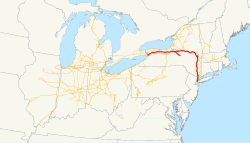New York, West Shore and Buffalo Railway

West Shore Railroad (red) and New York Central system (orange) as of 1918
|
|
| Locale |
Weehawken, New Jersey Buffalo, New York |
|---|---|
| Track gauge | 4 ft 8 1⁄2 in (1,435 mm) standard gauge |
The West Shore Railroad was the final name of a railroad from Weehawken, New Jersey, across the Hudson River from New York City, north along the west shore of the river to Albany, New York and then west to Buffalo. It was organized as a competitor to the New York Central and Hudson River Railroad, but was soon taken over by that company.
The first part of the line was built as the Saratoga and Hudson River Railroad, incorporated April 16, 1864 and opened in Spring 1866. After only about a year of independent operation, the line served as a branch of the New York Central Railroad (NYC), splitting at Athens Junction near Schenectady and running southeast and south along the west side of the Hudson River to Athens, New York. Early plans included acquiring the Saratoga and Schenectady Railroad as a northern extension. The Saratoga and Hudson River was bought and merged into the New York Central as their Athens Branch on September 9, 1867. The terminal at Athens was destroyed by fire in 1876. The line ran intermittently from then into the 1880s, with its tracks being torn up for good in 1888. It had been called the "White Elephant" Railroad for most of its existence because it quickly outlived whatever usefulness it may have had. Today a row of brick houses known as the Brick Row Historic District which was built in 1850 for the workers of the failed railroad stand in Athens as the only remaining structure related to the "White Elephant" Railroad project.
At the south end of the route, the Ridgefield Park Railroad was incorporated April 4, 1867. This was planned as a branch of the New Jersey Rail Road, splitting at Marion Junction and running north on the west side of the New Jersey Palisades via Ridgefield Park to the state line at Tappan, New York. Across the state line, the Rockland Central Railroad was incorporated May 23, 1870 to continue the line to Haverstraw, and the Rockland Central Extension Railroad, incorporated May 29, 1872, was to continue further north along the west side of the Hudson River. The Rockland Central and Rockland Central Extension merged on July 29, 1872 to form a new Rockland Central Railroad, and that company merged with the Ridgefield Park to form the Jersey City and Albany Railroad on June 24, 1873, with the intention of building a full line from Jersey City to Albany.
...
Wikipedia
